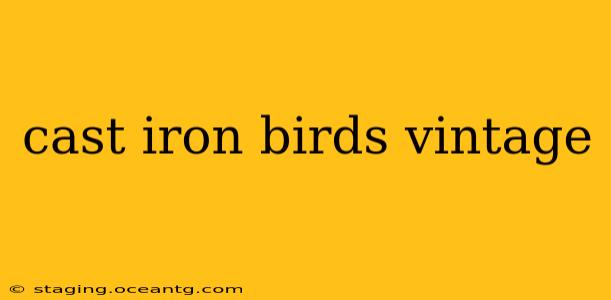Cast iron birds, with their charmingly rustic aesthetic and often surprisingly intricate detail, have become highly sought-after vintage collectibles. These aren't your mass-produced garden ornaments; they represent a piece of history, reflecting the craftsmanship and artistry of bygone eras. This article delves into the world of vintage cast iron birds, exploring their history, identifying marks to look for, and offering advice on care and appreciation.
What Makes Vintage Cast Iron Birds So Special?
The appeal of vintage cast iron birds extends beyond mere nostalgia. Their enduring quality, often stemming from the use of heavier, higher-quality iron than is common today, ensures that many survive in remarkably good condition. The individual character of each piece, due to the inherent imperfections of the hand-casting process, adds to their charm. Unlike modern mass-produced items, each vintage cast iron bird possesses a unique patina, telling a silent story of its age and journey. Many collectors appreciate the weight and heft of these pieces, a tangible connection to the past.
Identifying Authentic Vintage Cast Iron Birds: What to Look For
Authenticating vintage cast iron birds can be tricky. While there's no single foolproof method, several factors can help determine authenticity:
- Weight and Feel: Genuine cast iron is heavy. A lightweight piece is often a reproduction.
- Casting Marks: Look for imperfections and irregularities in the casting. These are characteristic of hand-casting and not present in modern mass-produced items.
- Patina: Authentic pieces will exhibit a natural patina, showing signs of age and wear. An overly uniform or artificial patina might indicate a reproduction.
- Maker's Marks: While not all vintage pieces are marked, the presence of a maker's mark, often a logo or initials, is a strong indicator of authenticity. Researching known manufacturers can be invaluable.
- Style and Design: Be aware of common design styles prevalent in different eras. Researching the history of cast iron production can help you date and authenticate a piece.
How Much Are Vintage Cast Iron Birds Worth?
The value of vintage cast iron birds is highly variable and depends on several factors:
- Rarity: Less common designs and birds from specific manufacturers fetch higher prices.
- Condition: The better the condition, the higher the value. Restoration can impact value, and poorly executed restoration often lowers it.
- Size: Larger birds generally command higher prices.
- Maker: Reputable manufacturers often have a significant impact on value.
It’s essential to research comparable pieces sold recently on reputable online auction sites and antique marketplaces to get a better idea of potential value.
What are the most sought-after types of cast iron birds?
The most sought-after types of vintage cast iron birds often depend on collector preferences, but some general trends include:
- Specific bird species: Birds of prey like eagles or owls, or more unusual species, are generally more desirable.
- Detailed designs: Birds with intricate details, such as feathering or beak shapes, tend to be more valuable.
- Unique poses: Birds in unusual or dynamic poses are often more sought-after.
- Early 20th-century pieces: Pieces from the early to mid-20th century are often prized for their craftsmanship and historical significance.
How to Care for Your Vintage Cast Iron Bird Collection
Proper care is crucial to preserving your cast iron birds. Here are some tips:
- Cleaning: Gently clean with a soft cloth and mild soapy water. Avoid abrasive cleaners.
- Storage: Store in a dry, cool place to prevent rust. Consider using individual bags or soft cloths to prevent scratches.
- Rust Prevention: Apply a light coat of beeswax or a specialized metal protectant to prevent rust, especially in humid environments.
Where Can I Find Vintage Cast Iron Birds?
Vintage cast iron birds can be found in a variety of places:
- Antique shops and flea markets: These are excellent places to find unique and often overlooked treasures.
- Online auction sites: Sites like eBay often have a wide selection of vintage cast iron birds.
- Antique shows and fairs: These events provide opportunities to meet sellers and learn more about the items.
Remember to carefully inspect any piece before purchasing, paying close attention to condition, authenticity, and potential damage.
By combining careful research, a keen eye for detail, and a passion for vintage collectibles, you can build a beautiful and valuable collection of cast iron birds. Happy hunting!
